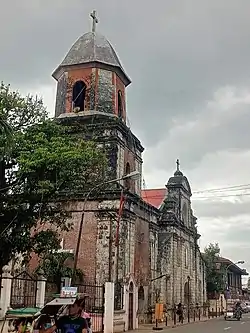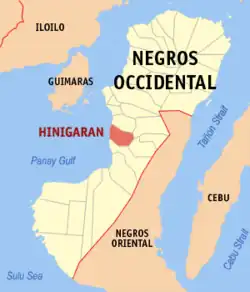Hinigaran | |
|---|---|
| Municipality of Hinigaran | |
 St. Mary Magdalene Parish Church, Hinigaran | |
 Flag | |
| Nickname(s): "The Gateway to Southern Negros" "The Oyster and Pyrotechnics Capital of Negros Occidental" | |
| Motto: "Hugpong Hinugyaw Hinigaranon" | |
 Map of Negros Occidental with Hinigaran highlighted | |
OpenStreetMap | |
.svg.png.webp) Hinigaran Location within the Philippines | |
| Coordinates: 10°16′N 122°51′E / 10.27°N 122.85°E | |
| Country | Philippines |
| Region | Western Visayas |
| Province | Negros Occidental |
| District | 5th district |
| Founded | 1768 |
| Barangays | 24 (see Barangays) |
| Government | |
| • Type | Sangguniang Bayan |
| • Mayor | Jose Nadie P. Arceo |
| • Vice Mayor | Mary Grace S. Arceo |
| • Representative | Emilio Bernardino L. Yulo III |
| • Municipal Council | Members |
| • Electorate | 53,198 voters (2022) |
| Area | |
| • Total | 154.92 km2 (59.81 sq mi) |
| Elevation | 5.0 m (16.4 ft) |
| Highest elevation | 43 m (141 ft) |
| Lowest elevation | 0 m (0 ft) |
| Population (2020 census)[3] | |
| • Total | 88,909 |
| • Density | 570/km2 (1,500/sq mi) |
| • Households | 22,592 |
| Economy | |
| • Income class | 1st municipal income class |
| • Poverty incidence | 19.36 |
| • Revenue | ₱ 325 million (2020) |
| • Assets | ₱ 738.1 million (2020) |
| • Expenditure | ₱ 241.6 million (2020) |
| • Liabilities | ₱ 305.3 million (2020) |
| Service provider | |
| • Electricity | Negros Occidental Electric Cooperative (NOCECO) |
| Time zone | UTC+8 (PST) |
| ZIP code | 6106 |
| PSGC | |
| IDD : area code | +63 (0)34 |
| Native languages | Hiligaynon Tagalog |
| Website | www |
Hinigaran, officially the Municipality of Hinigaran (Hiligaynon: Banwa sang Hinigaran; Tagalog: Bayan ng Hinigaran), is a 1st class municipality in the province of Negros Occidental, Philippines. According to the 2020 census, it has a population of 88,909 people.[3]
It is 52 kilometres (32 mi) south from Bacolod.
History
The early inhabitants of this town were the aboriginal people called "Mundos" and "Ambaks". When traders and settlers from Panay started moving in, the natives were driven to the mountains. The new settlers were called "Tagahigad" and when the Spaniards came the place was called "Ginigaran" from the word "higad" but it was later spelled and pronounced as Hinigaran.
The town was founded in 1765 and Captain Basilio Mongcal was appointed as the first president in 1806. Among its first settlers were the families of Mongcal, Lagtapon, Curio, Sario, David, Orin, Pido, Pabalinas, Luntayao, Javier, Vargas, Lucasan, Grijaldo, and Dano-og— some of whom were from Panay.
The Spaniards established the seat of the "pueblo" in Jacinto and Zamora Streets, and the town was governed by "Capitanes Municipales", Tenientes Absolato" and Cabeza de Barangays". When revolt against the Spanish Government broke out, Capitan Bibiano Gelvosa and his followers fought bravely against the Spaniards. He was the last "Capitan Municipal" when the Americans arrived.
Geography
Barangays
Hinigaran is politically subdivided into 24 barangays. Each barangay consists of puroks and some have sitios.
Climate
| Climate data for Hinigaran, Negros Occidental | |||||||||||||
|---|---|---|---|---|---|---|---|---|---|---|---|---|---|
| Month | Jan | Feb | Mar | Apr | May | Jun | Jul | Aug | Sep | Oct | Nov | Dec | Year |
| Mean daily maximum °C (°F) | 30 (86) |
31 (88) |
32 (90) |
33 (91) |
32 (90) |
30 (86) |
29 (84) |
29 (84) |
29 (84) |
29 (84) |
30 (86) |
30 (86) |
30 (87) |
| Mean daily minimum °C (°F) | 22 (72) |
22 (72) |
22 (72) |
24 (75) |
25 (77) |
25 (77) |
25 (77) |
25 (77) |
24 (75) |
24 (75) |
23 (73) |
23 (73) |
24 (75) |
| Average precipitation mm (inches) | 38 (1.5) |
29 (1.1) |
55 (2.2) |
65 (2.6) |
141 (5.6) |
210 (8.3) |
212 (8.3) |
176 (6.9) |
180 (7.1) |
180 (7.1) |
130 (5.1) |
70 (2.8) |
1,486 (58.6) |
| Average rainy days | 9.0 | 7.2 | 11.1 | 13.5 | 25.6 | 28.4 | 28.9 | 27.3 | 26.9 | 27.7 | 21.8 | 13.8 | 241.2 |
| Source: Meteoblue[5] | |||||||||||||
Demographics
| Year | Pop. | ±% p.a. |
|---|---|---|
| 1903 | 14,256 | — |
| 1918 | 16,097 | +0.81% |
| 1939 | 27,438 | +2.57% |
| 1948 | 29,017 | +0.62% |
| 1960 | 36,240 | +1.87% |
| 1970 | 46,010 | +2.41% |
| 1975 | 52,018 | +2.49% |
| 1980 | 54,717 | +1.02% |
| 1990 | 68,739 | +2.31% |
| 1995 | 71,519 | +0.75% |
| 2000 | 74,997 | +1.02% |
| 2007 | 80,528 | +0.99% |
| 2010 | 81,925 | +0.63% |
| 2015 | 85,602 | +0.84% |
| 2020 | 88,909 | +0.75% |
| Source: Philippine Statistics Authority[6][7][8][9] | ||
The people in the town speak the Hiligaynon language (often called Ilonggo). Filipino and English are generally understood.
Economy
Economic profile
- Total Internal Revenue Allotment: Php P180,762,087 (2018)
- Total Income: Php 158,600,789.72 (2015)
- Major Industry: Agriculture and fishing
- Products: Nylon shell, Capiz shell, Talaba, firecrackers manufacturing
- Market Days: Thursdays and Sunday
- Town Fiesta: April 30 (Hinugyaw Festival)
- Patronal Fiesta: July 22 (Kampana Festival)
- Patron Saint: Saint Mary Magdalene
Malls/Supermarkets
- Metro Gaisano Mall
- Lopues Value Store
- Prince Hypermart
- Puregold
- Melva's Grocery
- D'Garisson Mini Mart
- Negros Grace Pharmacy Grocery Store
- Mercury Drug Store w/ Grocery Store
- KJ Fairmart
Upcoming Malls/Supermarkets
- CityMall (Coming soon)
- Savemore (Coming soon)
- Gaisano Grand Mall (Coming soon)
Banking Institutions
- BDO
- RCBC
- Producers Bank
- Banko (a subsidiary of BPI)
- Land Bank (Coming soon)
- Development Bank of the Philippines (Coming soon)
- Metro Bank (Coming soon)
- Philippine National Bank (Coming soon)
- EastWest Bank (Coming soon)
Health Services
- Hinigaran Community Hospital
- Hinigaran Doctor's Hospital
- Hinigaran Holy Mother of Mercy Hospital
Media Network
- 105.7 Radyo Natin Hinigaran
- 89.7 K5 News FM Hinigaran
Education
- Number of Elementary Schools : 25
- Number of Secondary Schools : 7
- Hinigaran National High School
- Hinigaran Institute
- Madeleine Academy
- Pahilanga National High School
- Negros Occidental National Agro-Industrial School of Home Industries
- Esteban Jalandoni National High School Calapi Main/ Baga-as Extension
- Fundamental Baptist Christian School
- Number of college :2 — Central Philippines State University – Hinigaran Campus (2011)
- Southern Negros Polytechnic University (coming soon)
Tourism
- San Jose Muscovado Sugar Mill
- Barangay Pilar World War II Marker
- Mary Magdalene Church
- Talabahan Plantation
- Paradiso del Sur Beach Resort
- Mini Rizal Park
- Canonoy Beach Resort
- Bulobito-on Beach Resort
- Makikiling Point Beach Resort
- Senator Esperidion Guanco Bridge
- Espiso Beach Resort
- Tagda Pier
- Linao Lake Farm Resort
- Hinigaran Sakura Tree
References
- ↑ Municipality of Hinigaran | (DILG)
- ↑ "2015 Census of Population, Report No. 3 – Population, Land Area, and Population Density" (PDF). Philippine Statistics Authority. Quezon City, Philippines. August 2016. ISSN 0117-1453. Archived (PDF) from the original on May 25, 2021. Retrieved July 16, 2021.
- 1 2 Census of Population (2020). "Region VI (Western Visayas)". Total Population by Province, City, Municipality and Barangay. Philippine Statistics Authority. Retrieved 8 July 2021.
- ↑ "PSA Releases the 2018 Municipal and City Level Poverty Estimates". Philippine Statistics Authority. 15 December 2021. Retrieved 22 January 2022.
- ↑ "Hinigaran: Average Temperatures and Rainfall". Meteoblue. Retrieved 7 May 2020.
- ↑ Census of Population (2015). "Region VI (Western Visayas)". Total Population by Province, City, Municipality and Barangay. Philippine Statistics Authority. Retrieved 20 June 2016.
- ↑ Census of Population and Housing (2010). "Region VI (Western Visayas)" (PDF). Total Population by Province, City, Municipality and Barangay. National Statistics Office. Retrieved 29 June 2016.
- ↑ Censuses of Population (1903–2007). "Region VI (Western Visayas)". Table 1. Population Enumerated in Various Censuses by Province/Highly Urbanized City: 1903 to 2007. National Statistics Office.
{{cite encyclopedia}}: CS1 maint: numeric names: authors list (link) - ↑ "Province of". Municipality Population Data. Local Water Utilities Administration Research Division. Retrieved 17 December 2016.
- ↑ "Poverty incidence (PI):". Philippine Statistics Authority. Retrieved December 28, 2020.
- ↑ "Estimation of Local Poverty in the Philippines" (PDF). Philippine Statistics Authority. 29 November 2005.
- ↑ "2003 City and Municipal Level Poverty Estimates" (PDF). Philippine Statistics Authority. 23 March 2009.
- ↑ "City and Municipal Level Poverty Estimates; 2006 and 2009" (PDF). Philippine Statistics Authority. 3 August 2012.
- ↑ "2012 Municipal and City Level Poverty Estimates" (PDF). Philippine Statistics Authority. 31 May 2016.
- ↑ "Municipal and City Level Small Area Poverty Estimates; 2009, 2012 and 2015". Philippine Statistics Authority. 10 July 2019.
- ↑ "PSA Releases the 2018 Municipal and City Level Poverty Estimates". Philippine Statistics Authority. 15 December 2021. Retrieved 22 January 2022.
Remy Presas- Father of Martial Arts